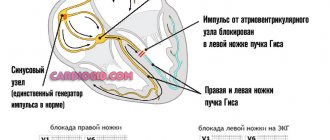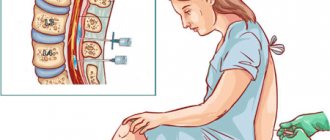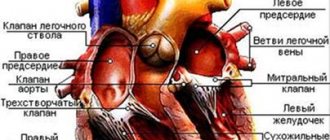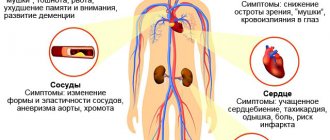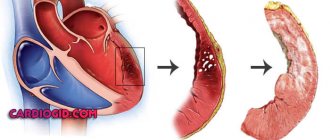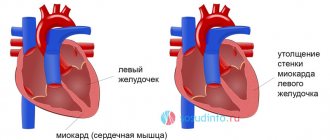Bundle branch block - what is it, why is this condition dangerous? Bundle branch block is characterized by incomplete or complete blocking of one or two branches simultaneously. The latter is a complete block of the bundle branch, the first is partial.
This conduction disorder is intermittent or permanent. The bundle of His consists of the left and right bundle branches. The first is divided into 2 branches: posterior and anterior. Impulses pass through them to the ventricles, after which the latter contract. Any blocking of excitation impulses leads to the development of various types of arrhythmia.
RBBB is not a separate independent disease, but a consequence and electrocardiological manifestation of the underlying cardiac pathology. In patients with age, the detection rate of this disorder increases.
Reasons for the blockade
Bundle branch block can be caused by various reasons.
| Right bundle branch block | occurs in diseases accompanied by overload and hypertrophy of the right ventricle - mitral stenosis, atrial septal defect, tricuspid valve insufficiency, coronary artery disease, cor pulmonale, arterial hypertension, acute myocardial infarction (posterior phrenic or apical), etc. |
| Left bundle branch block | include atherosclerotic cardiosclerosis, aortic valve defects, cardiomyopathy, myocardial infarction, myocarditis, bacterial endocarditis, myocardial dystrophy. Less commonly, bundle branch block develops against the background of pulmonary embolism, hyperkalemia and intoxication with cardiac glycosides. |
The causes of double-bundle blocks are usually aortic defects (aortic insufficiency, aortic stenosis) and coarctation of the aorta.
Causes and risk factors
Causes that can cause disruption of the conduction of excitation along the structures of the His bundle are divided into cardiac and extracardiac.
Cardiac causes of blockades:
- congenital and acquired heart defects (stenosis of the aortic orifice, pulmonary artery, left atrioventricular orifice, coarctation, or segmental narrowing, aortic orifice, insufficiency of the aortic, mitral valves, pulmonary valve, atrial septal defects);
- cardiomyopathy (including hypertrophic obstructive cardiomyopathy);
- coronary artery diseases;
- dystrophic changes in the myocardium;
- idiopathic calcification of the cardiac conduction system;
- Brugada syndrome;
- fibrous changes in the bundle branches;
- coronary heart disease (including previous myocardial infarction);
- cardiosclerosis (including post-infarction);
- Lewy disease;
- heart failure;
- myocarditis;
- endocarditis;
- left ventricular myocardial hypertrophy.
Every fifth patient diagnosed with myocardial infarction already has a bundle branch block or develops against the background of an acute condition.
Extracardiac causes:
- intoxication with drugs from the group of cardiac glycosides, quinidine, beta-blockers;
- thyrotoxicosis;
- electrolyte imbalance;
- severe or long-term diabetes mellitus;
- Iron-deficiency anemia;
- metabolic syndrome;
- nutritional obesity;
- chronic alcohol disease;
- autoimmune diseases (rheumatoid arthritis, systemic lupus erythematosus, autoimmune thyroiditis);
- pulmonary embolism;
- chronic obstructive pulmonary diseases (obstructive bronchitis, bronchial asthma);
- long history of smoking.
Classification
Depending on the number of elements of the His bundle, in which a violation of the impulse conduction is observed, the blockade occurs:
Single-bundle, when impulse conduction through one element of the His bundle is impaired with blockade:
- right bundle branch;
- anterior branch of the left bundle branch;
- posterior branch of the left bundle branch.
Double-bundle, when the conduction of cardiac impulses along two elements of the His bundle is impaired with blockade:
- anterior and posterior branches of the left bundle branch;
- right leg and anterior branch of the left bundle branch;
- the right bundle and the posterior branch of the left bundle branch.
- Three-bundle with blockade along all elements of the His bundle.
The blockade can be complete or incomplete, constant or intermittent (appears and disappears when recording one ECG), transient (not recorded in the ECG), or alternating (when different legs are blocked when recording one ECG).
Types of blockades
As a rule, all blockades are divided into 3 main types:
- Single-bundle - it can affect the right leg, as well as one of the branches of the left process.
- Two-budded - this variety immediately affects both left-sided branches or the right and one of the branches of the left.
- Three-bundle is the most serious pathology in which 3 branches are affected at once.
In turn, LBBB can occur in several scenarios:
- the blockade occurs in a certain part of the trunk up to the branching boundary;
- The stem part is completely affected before it branches;
- the blockade affects the process on both sides after branching;
- both peripheral parts of the left process are blocked;
- scattered changes in the middle muscle layer of the heart.
LBBB is a type of conduction disorder that in many cases does not have a clear clinical picture. Men over 55 years of age are more likely to experience this pathology.
Symptoms
Right bundle branch block is asymptomatic and is an incidental finding detected based on the results of an ECG study during a routine medical examination, medical examination or treatment for other diseases. Single-bundle (anterior or posterior) left blockades also do not have clinically significant manifestations.
Left bundle branch block has symptoms of the disease that caused it, most often these are:
- decreased exercise tolerance;
- shortness of breath with slight physical exertion;
- interruptions in heart function;
- palpitations;
- pain in the heart area;
- change in heart sounds during auscultation [weakened or prolonged 1st tone (in 70% of cases), less often (16% of cases) - its splitting, splitting of the 2nd tone (80%)].
Three-fascicle blockade has the most severe clinical manifestations:
- extremely low heart rate – 20–40 beats/min;
- severe shortness of breath at rest;
- interruptions in heart function;
- heart rhythm disturbances;
- dizziness;
- short-term episodes of loss of consciousness;
- cyanosis of the skin.
Blockades and heart rhythm disturbances in pregnant women
Even with complete heart block, the prognosis for pregnant women is favorable, women calmly carry and give birth to both their first and second children, so even a complete cessation of impulse transmission is not an obstacle for women who want to have children, and termination of pregnancy is not indicated for them.
Pregnancy is considered unacceptable only if the heart rate drops to forty beats per minute, as well as in severe valve diseases requiring immediate surgical intervention.
Problems in which termination of pregnancy saves the life of the mother:
Up to twelve weeks
- Bearing a fetus is impossible with ventricular extrasystole of the third and fourth classes, according to Lown.
- Heart rhythm disturbance.
- Cardiomyopathy is arrhythmogenic.
What does bundle branch block look like on an ECG?
ECG signs characterizing a complete block of the right bundle branch include:
- An increase in the duration of the QRS complex beyond 0.120 seconds.
- The presence of a deformed long S wave in leads V4-V6.
- The presence of a three-phase (similar to the letter “M”) QRS in leads V1-V3.
Speaking about the signs of incomplete blockade of the right bundle branch, it is worth noting the absence of a pathologically long QRS complex on the ECG (its length is either normal or is at the upper limit of normal in the range from 0.090 to 0.110 seconds), but the presence of triphasicity when visually assessing the shape of the ventricular complexes.
Visual signs of complete (affecting both branches) blockade of the left leg on the ECG include:
- There may be a prolongation of the ventricular complex beyond 0.120 seconds.
- The presence of deep long S waves in leads V4-V6.
- The presence of long and deformed R waves in leads I, aVL and V5-V6.
- Absence of Q on graphs I, V5-V6.
The blockade of the anterior branch of the left bundle branch of His looks like this:
- A pronounced deviation of the heart axis to the left side (from -30 to -90 degrees).
- Ventricular complex of normal duration.
- Small R waves combined with deep S waves in II, III and aVF.
- Small Q waves in I and aVL.
Blockade of the posterior branch of the left leg of His looks like:
- A pronounced deviation of the heart axis to the right side (from +120 to +180 degrees).
- Ventricular complex of normal duration.
- Small Q waves in combination with high-amplitude R waves in II, III and aVF.
- Small R waves in I and aVL.
If the above-mentioned signs that fit the description of a blockade of the legs are detected on the ECG, the doctor must identify the root cause of this rhythm disturbance and make a diagnosis in accordance with government recommendations, and consider the blockade itself to be a manifestation of the disease.
Left bundle branch block
Right bundle branch block
Blockade of the right leg together with the left posterior branch of the His bundle
Diagnosis and symptoms
There are no symptoms that would signal the onset of the disease. That is why deviations are rarely detected at the initial stages. Sometimes arrhythmia may occur, but doctors do not associate it with this pathology, since there are too many reasons for which it can occur. Most often, the symptoms completely coincide with the disease that the person suffers, without having any pronounced independent signs.
Important! You can prevent such a serious problem if you are regularly examined and, in particular, have an electrocardiogram. In this case, the presence of any abnormalities, including on the posterior wall of the heart muscle, will be detected in time.
Diagnosis is carried out using an ECG, which usually reveals a deviation on the QRS axis to the left. In this case, the S and R waves are very pronounced. Diagnosis is not limited to just an ECG, since this will not allow determining either the type of disease and the site of occurrence, or, of course, prescribing treatment. Therefore, MRI and other more in-depth studies may be prescribed as additional techniques.
Sometimes the blockade may be incomplete, and then this is reflected on the ECG. So, the alpha angle is located in the region of 40-60 degrees. An intermediate position is noticeable in the diagnosis. A sharp displacement of the axis is already considered a violation of electrical conductivity, and with the help of additional measures it is ultimately clarified which factor causes the deviation.
Consequences
Bundle branch block requires timely diagnosis, since if left untreated, the disease causes serious consequences, sometimes incompatible with the patient’s life. Among them are:
- tachycardia;
- ventricular fibrillation;
- thromboembolism;
- heart failure;
- heart attack;
- stroke;
- sudden death.
To prevent these complications, it is recommended to undergo regular preventive medical examinations. If heart pain, shortness of breath and other signs of the disease appear, you should contact a specialist immediately. [adsen]
Diagnostics
When visiting a hospital, a patient needs to undergo a number of differentiated diagnostic procedures to make an accurate diagnosis. These are different methods, they are selected individually, the doctor can prescribe to the patient:
- stationary electrocardiography and its varieties (transesophageal electrocardiography, rhythmocardiography);
- 24-hour ECG monitoring is often carried out using a device.
Since it is necessary to differentiate the disease and identify the main cause of its occurrence, it is permissible to conduct other examinations; the list should include:
- PET of the heart.
- EchoCG or ultrasound of the heart.
The condition requires contacting several specialists; you will have to make an appointment with:
- cardiologist;
- arrhythmologist;
- or a heart surgeon.
Just one specialist will be enough, but if there are problems with making a diagnosis, consultation with various doctors will be required.
A cardiac surgeon will help you decide on the placement of a stimulator; against the background of a long and uncompensated course of pathological processes, the likelihood of developing heart failure increases. Surgical procedures will help correct the situation and eliminate unpleasant signs.
Treatment for bundle branch block
Treatment of the pathology depends on the type and electrocardiographic indicators at the time of diagnosis. Special treatment for damage to the right bundle branch is most often not required. In this case, the patient is recommended to follow measures aimed at preventing complications of the pathology.
To do this, the patient should adhere to the following rules:
- harden, douse yourself with cold water;
- respond adequately to stress;
- introduce teas into the diet, including soothing herbs (valerian, motherwort, elderberry, linden, nettle, oregano);
- give up heavy physical work and strength sports;
- maintain proper nutrition, avoid foods that increase cholesterol levels in the blood;
- exclude fatty, spicy, fried, smoked foods, mayonnaise, sauces, marinades, ketchups.
There is no specific drug treatment for this conduction disorder. Patients with right bundle branch block in the absence of an underlying disease do not require treatment. For patients with single- or double-fascicular blockade, the following groups of drugs can be prescribed for the treatment of the underlying disease:
- antioxidants – ubiquinone, carnitine, mexidol, preductal;
- vitamins – thiamine (vitamin B1) with lipoic acid, riboflavin (vitamin B2), nicotinic acid (vitamin PP);
- sedatives of plant origin (St. John's wort, motherwort, valerian, sage);
- antiplatelet agents to prevent thrombus formation in the heart and blood vessels - aspirin, cardiomagnyl, thrombo Ass;
- lipid-lowering drugs to normalize cholesterol levels - statins (rosuvastatin, atorvastatin, simvastatin);
- ananginal drugs for the treatment of coronary heart disease - short- and long-acting nitrates (nitroglycerin, isoket, cardiquet, monocinque);
- drugs for the treatment of diseases of the bronchopulmonary system that have caused the development of pulmonary heart disease - inhaled adrenomimetics and glucocorticosteroids (Berotec, Berodual, Spiriva, Beclazone);
- antihypertensive drugs for the treatment of arterial hypertension - ACE inhibitors (perindopril, lisinopril), angiotensinogen II receptor antagonists (losartan, valsartan), beta blockers (bisoprolol, atenolol), calcium channel antagonists (amlodipine, verapamil). The last two groups should be prescribed with caution, as they reduce the heart rate;
- antibiotics, non-steroidal anti-inflammatory drugs for inflammation of the membranes of the heart - penicillin; nimesulide, diclofenac;
- diuretics and cardiac glycosides in the development of chronic heart failure - indapamide, diuver, lasix; strophanthin, digoxin.
In addition to medication, a surgical method of blockade treatment is used, which consists of installing a pacemaker (pacemaker) in the patient. Complete right blockade, especially in combination with left hemiblockade (blockade of one branch of the left leg), and complete left blockade, developed in the acute period of myocardial infarction (10 - 14 days), are an indication for temporary cardiac pacing by introducing an electrode through the central vein into the right ventricle
Three-fascicle blockade with complete atrioventricular block, a rare rhythm of ventricular contractions and with Morgagni-Edams-Stokes attacks (attacks of loss of consciousness) is an indication for permanent cardiac pacing (implantation of an artificial pacemaker or cardioverter-defibrillator).
Symptoms of complete LBBB
Characterized by the maximum possible clinical picture. It is considered the most severe type of pathological process.
- Constant arrhythmias. As myocardial contractility decreases, the likely scenario is bradycardia with a beat rate of about 40-50 beats per minute, possibly less. In addition to heart rate disturbances, other abnormalities also occur. Group-type extrasystole often occurs, when the left ventricle begins to produce a signal and contract chaotically on its own.
- Chest pain. Non-specific sign. Characterized by mild discomfort. There are no attacks as such, except for cases of coronary insufficiency.
- Shortness of breath during prolonged physical activity or at rest. Depends on the degree of development of the underlying pathological condition. Severe disability is possible with the inability to even serve oneself at home, not to mention professional activities.
- Weakness, feeling of body weakness, periods of apathy. Included in the picture. They represent general manifestations.
- Paleness of the skin.
- Cyanosis of the nasolabial triangle.
- Sweating, especially at night.
- Mental disorders. Like aggressiveness, irritability, long periods of depression or low emotional levels.
- Fainting. May be repeated over the course of one day.
- Headache.
- Vertigo.
- Impossibility of orientation in space.
- Blood pressure surges.
The clinical picture may vary, depending on the underlying diagnosis and the degree of blockage.
Forecast
In conclusion, it should be said that bundle branch block is not a disease, but symptoms of heart disease that can manifest themselves clinically or be detected on an ECG. It is necessary to take into account the causes of the blockade, prescribe adequate treatment, and in this case it is possible to assume the consequences of a particular blockade.
If the patient has a single-fascicle right block and there are no pathologies of the heart and lungs, we can talk about a favorable prognosis.
An unfavorable prognosis in the case of a complete block of the left leg due to myocardial infarction, since in this case the mortality rate is 40-50 cases out of 100. In cases where the block is three-fascicle, there is a high probability of developing asystole and the prognosis is also unfavorable.
Treatment
There is no specific treatment for this pathology; First of all, the underlying disease is corrected with nitrates, cardiac glycosides, and antihypertensive drugs.
For right bundle branch block in the absence of an underlying disease, pharmacotherapy is not indicated.
For left leg block or three-fascicular block, the following therapy is prescribed:
- vitamin preparations of group B;
- antioxidants and antihypoxants;
- antiplatelet agents;
- lipid-lowering drugs.
For left bundle branch block or three-bundle block, drug therapy is indicated
If pharmacotherapy is ineffective, surgical treatment is indicated.
Prevention
Preventive measures include:
- avoidance of stressful situations;
- giving up alcohol and smoking;
- daily routine, full and restful sleep;
- refusal of fried, canned and spicy foods;
- taking medications only prescribed by a doctor and under his supervision;
- consumption of foods with a significant fiber content: fresh fruits and vegetables, herbs;
- timely diagnosis and treatment of diseases of all organs, not just the heart;
- mandatory consultation with a doctor if symptoms of the disease appear.
If an operation has been performed to install a pacemaker, a person should exclude the influence of electrical devices and a mobile phone on him. If you become ill, it is important to visit your doctor in a timely manner to assess the condition of the heart and the general well-being of the patient.
1Anatomy
Conducting system
Before studying the clinical picture and causes of dysfunction in the pathways, let’s look at how the His bundle is structured. This element is a direct continuation of the AV node, which is located between the upper and lower cardiac chambers and is the center of 2nd order automatism. The AV node receives impulses from a higher center - the sinoatrial, processes and carries out the impulse further along the His bundle.
The bundle branches into two legs: right and left. In turn, the left branch is divided into anterior and posterior, which, continuing to branch, end in Purkinje fibers. Pathology of the left leg in the form of slowing or absence of impulses means blockade of the left ventricle to a greater extent, since these branches of the conduction system intertwine this particular cardiac region.
